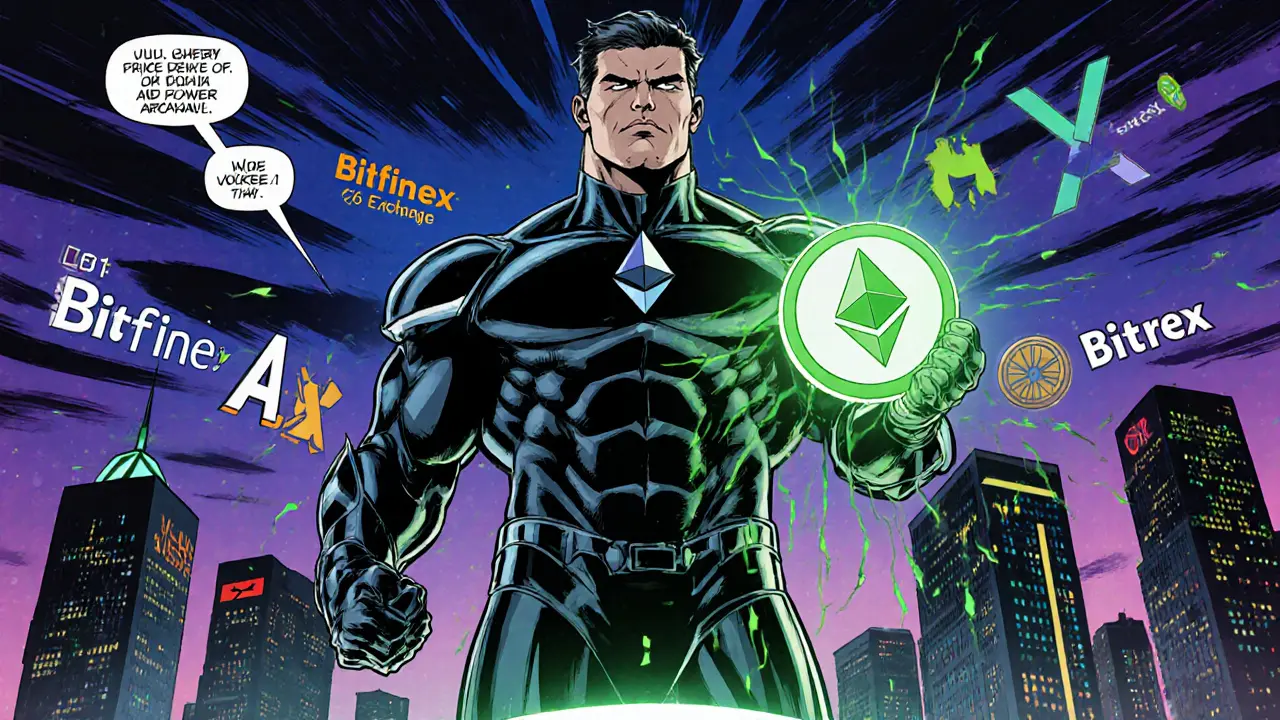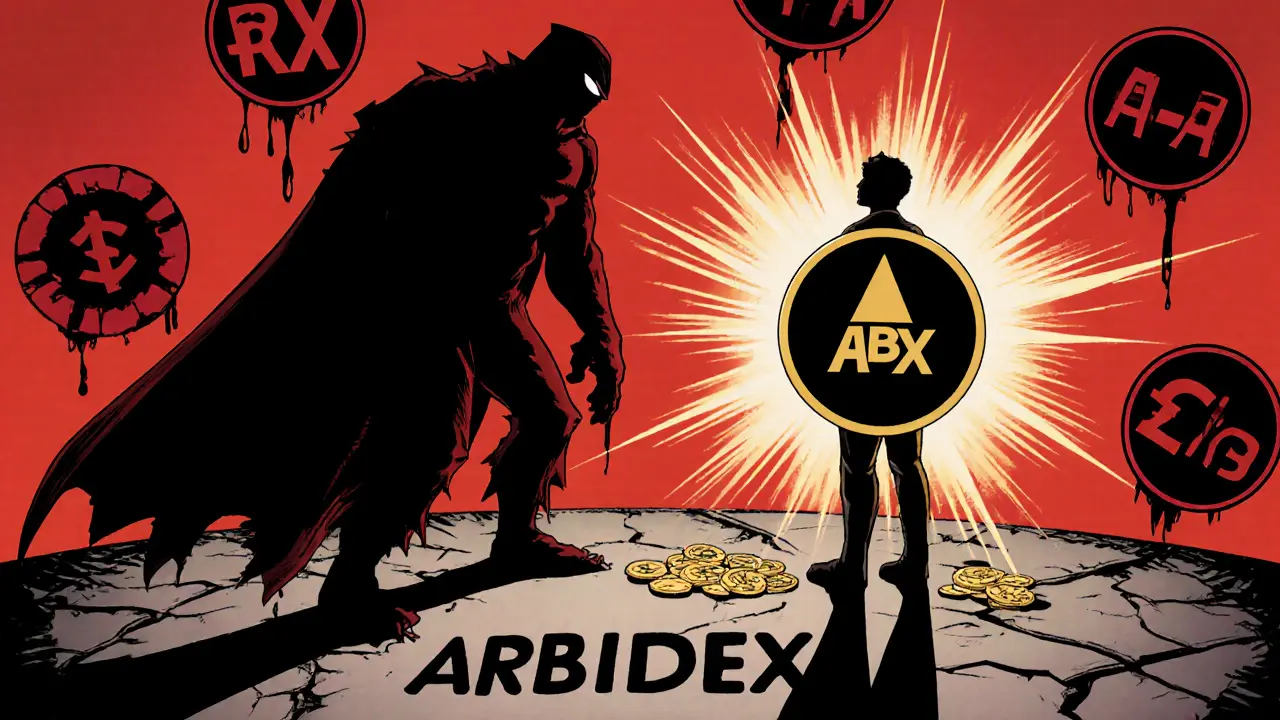
Arbitrage Profit Calculator
Arbidex Arbitrage Profit Calculator
Estimate potential profit from crypto arbitrage opportunities on Arbidex. Based on the article, you'll need to consider:
- Current spreads between exchanges
- ABX token fee discounts (10-20%)
- Slippage and network fees
- Low liquidity risks
Price on cheaper exchange (e.g., $20,000.50)
Price on more expensive exchange (e.g., $20,005.75)
Amount to trade in BTC (e.g., 0.5 BTC)
Percentage of ABX held (0-100%). Higher percentage means better fee discounts.
Typical slippage for crypto trades (0.1-0.5%)
Gas fees for Ethereum transactions
When you spot the ticker ABX (Arbidex Token), you’re looking at an ERC‑20 utility token that powers the Arbidex platform’s cross‑exchange arbitrage engine.
Quick Summary
- Arbidex is a crypto‑trading platform that runs automated arbitrage across major exchanges.
- ABX is the native ERC‑20 token; it unlocks lower fees, higher trade limits and auto‑arbitrage access.
- The token’s total supply is fixed at 25million, but circulating supply data is uncertain.
- Price peaked at $0.1357 in 2018 and today trades below $0.001, with very low volume.
- Risks include shrinking arbitrage opportunities, low liquidity and unclear project activity.
What is Arbidex?
Arbidex positions itself as a one‑stop window that aggregates price data from multiple crypto exchanges via API connections. By scanning price feeds at roughly 1,000times per second, the platform spots spread differences-situations where Bitcoin, for example, might be $0.5 cheaper on ExchangeA than on ExchangeB. When a profitable gap appears, Arbidex’s bots automatically buy on the cheaper market and sell on the higher one, pocketing the spread.
The service is built on bilateral agreements with well‑known exchanges such as Bitfinex, Okex, Bittrex, Poloniex, Huobi and Quoine. Those agreements let Arbidex negotiate preferential commission rates, which it then passes on to users. In practice, a trader only completes a single KYC check on Arbidex rather than repeating verification on each individual exchange.
How the ABX Token Powers the Platform
The ABX token serves three core purposes within the ecosystem:
- Fee discounts - Holding ABX reduces the commission on each arbitrage trade.
- Higher limits - More ABX means larger allowable deposit sizes and higher monthly trade caps.
- Auto‑arbitrage access - Only token‑holding accounts can trigger the fully automated arbitrage bots.
Because the token is an ERC‑20 asset, it lives on the Ethereum blockchain. The smart‑contract defines a fixed maximum supply of 25million ABX. Public data sources have reported a circulating supply of zero, which suggests either a distribution pause or outdated reporting.

Technical Architecture
At the heart of Arbidex is an API‑driven data‑aggregation layer. Each partner exchange streams order‑book snapshots to Arbidex’s servers, where a real‑time engine performs the following steps:
- Normalize price data across differing quote currencies.
- Run a spread‑calculation algorithm 1,000times per second.
- Validate the profitability after accounting for fees, slippage and network latency.
- Send signed trade orders to the relevant exchanges via their APIs.
The entire loop typically completes within milliseconds, giving the platform a speed edge over manual traders but still slower than ultra‑low‑latency institutional bots that sit directly on exchange matching engines.
Token Economics & Utilities
Besides fee discounts, ABX tokenomics are structured around a tiered service model:
| Attribute | ABX Token | Typical ERC‑20 Token |
|---|---|---|
| Supply | 25000000 (fixed) | Varies; often capped or deflationary |
| Primary Utility | Platform fee discount, trade‑limit boost, auto‑arbitrage | Governance, staking, utility in dApps |
| Circulating Supply (reported) | 0 (questionable) | Transparent on Etherscan |
| Price All‑Time High | $0.1357 (Oct2018) | Depends on project |
| Current Price (Oct2025) | ≈$0.00047 | Varies widely |
| Liquidity | Very low (≤0.5% of market cap daily) | Generally higher for established tokens |
The low liquidity means large buys or sells can swing the price dramatically, a risk that traders need to factor into any arbitrage calculations.
Market Performance & Risks
Historical data shows a dramatic 99.65% plunge from the 2018 peak. Trading volume is sporadic, with less than half of the days recording a positive close. Algorithmic sentiment scores label ABX as “bearish” and flag the token as high‑risk due to its thin order books.
Key risk factors include:
- Reduced arbitrage gaps - As major exchanges tighten spreads, profit windows shrink.
- Competition - Institutional firms now connect directly to exchanges, bypassing intermediaries.
- Liquidity crunch - Small market depth amplifies price impact.
- Project vitality - No public roadmap updates since 2019 raise concerns about ongoing development.
Long‑term price forecasts from some algorithmic models suggest a potential rise to $1.12 within ten years, but that projection rests on many “if” conditions that currently look shaky.

How to Get Started
- Visit the official Arbidex website and register an account.
- Complete the single KYC questionnaire - you’ll upload a photo ID and proof of address.
- Deposit Ethereum (or another supported asset) into the platform wallet.
- If you own ABX, transfer it to the same wallet to unlock fee discounts and auto‑arbitrage.
- Set your risk parameters - maximum trade size, stop‑loss thresholds, etc.
- Activate the “Auto‑Arbitrage” toggle; the system will now trade on your behalf.
Because the platform’s fees are already lower than many exchanges, holding ABX can cut those fees by an additional 10‑20%. However, the overall profitability still hinges on the existence of viable spreads.
Pros and Cons
Summarizing the main strengths and weaknesses helps you decide quickly:
- Pros
- Single KYC for many exchanges.
- Reduced fees for token holders.
- Automated arbitrage removes manual monitoring.
- Cons
- Very low token liquidity and uncertain circulating supply.
- Diminishing arbitrage opportunities in a mature market.
- Limited recent development updates, suggesting possible dormancy.
Frequently Asked Questions
What does the ABX token actually do?
ABX acts as a utility token on the Arbidex platform. Holding it gives you lower trading commissions, higher deposit and trade limits, and access to the fully automated arbitrage bots.
Is Arbidex still active in 2025?
Public information points to very low trading volume and no recent roadmap announcements. While the platform’s website is reachable, the lack of updates suggests limited activity or a dormant state.
How can I buy ABX?
ABX is listed on a few minor exchanges. You can purchase it with Ethereum or BinanceCoin on those markets, then transfer the tokens to your Arbidex wallet to unlock platform benefits.
What are the main risks of using Arbidex?
The biggest risks are shrinking arbitrage spreads, very low ABX liquidity, and uncertainty about the platform’s ongoing development. If spreads disappear, the core business model collapses.
Do I need to hold ABX to trade on Arbidex?
You can trade manually without ABX, but you will miss out on fee discounts and the auto‑arbitrage feature, which are exclusive to token holders.
Overall, Arbidex offers a clever solution for crypto arbitrage, but its token’s thin market and the platform’s quiet recent history make it a high‑risk play. If you decide to experiment, start with a small amount, keep an eye on spread opportunities, and constantly reassess whether the fees saved outweigh the liquidity risk.

Melanie Birt
October 13, 2025 AT 02:06Arbidex’s fee‑discount mechanism hinges on the proportion of ABX you hold, so the more token you stash, the lower the trading fees you’ll pay.
For example, a 15% ABX holding typically knocks about 12‑15% off the standard 0.3% exchange fee.
That reduction can be a game‑changer when you’re swinging thin arbitrage spreads.
Don’t forget to factor in network gas costs; on Ethereum they can easily eat a 0.1% slippage window.
Also keep an eye on liquidity depth – a shallow order book can turn a nice spread into a costly slippage trap. 😊